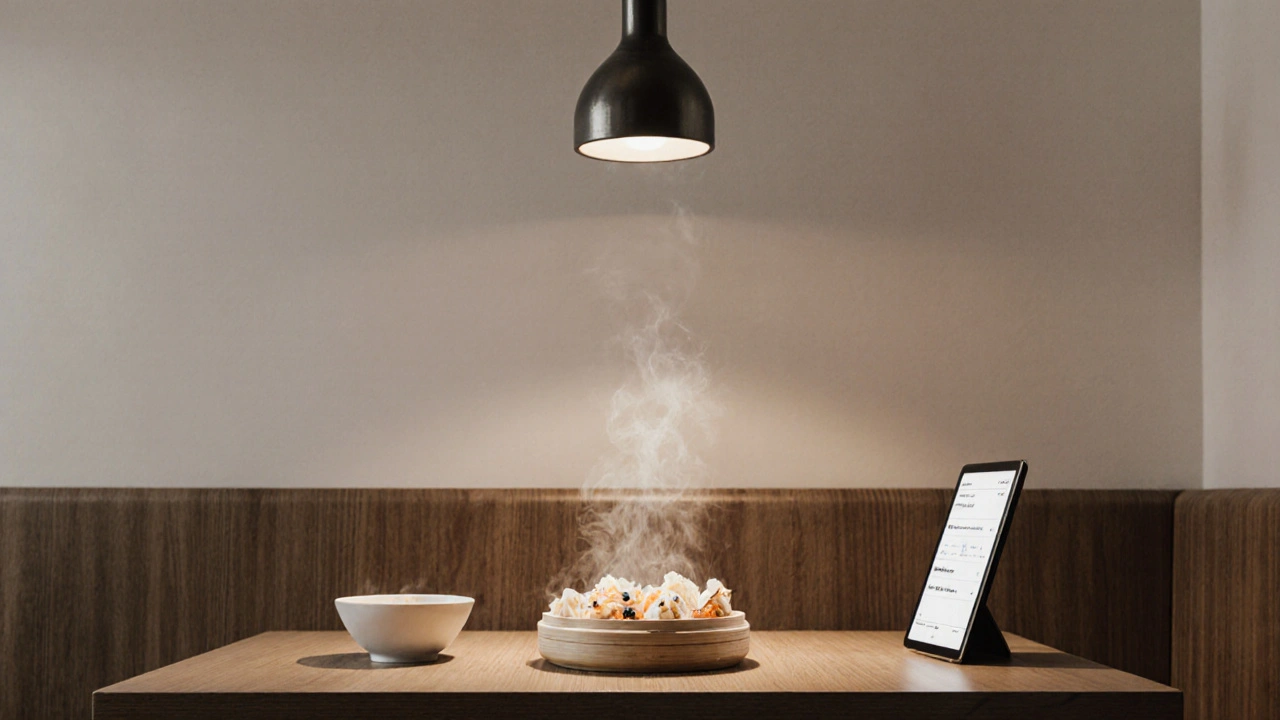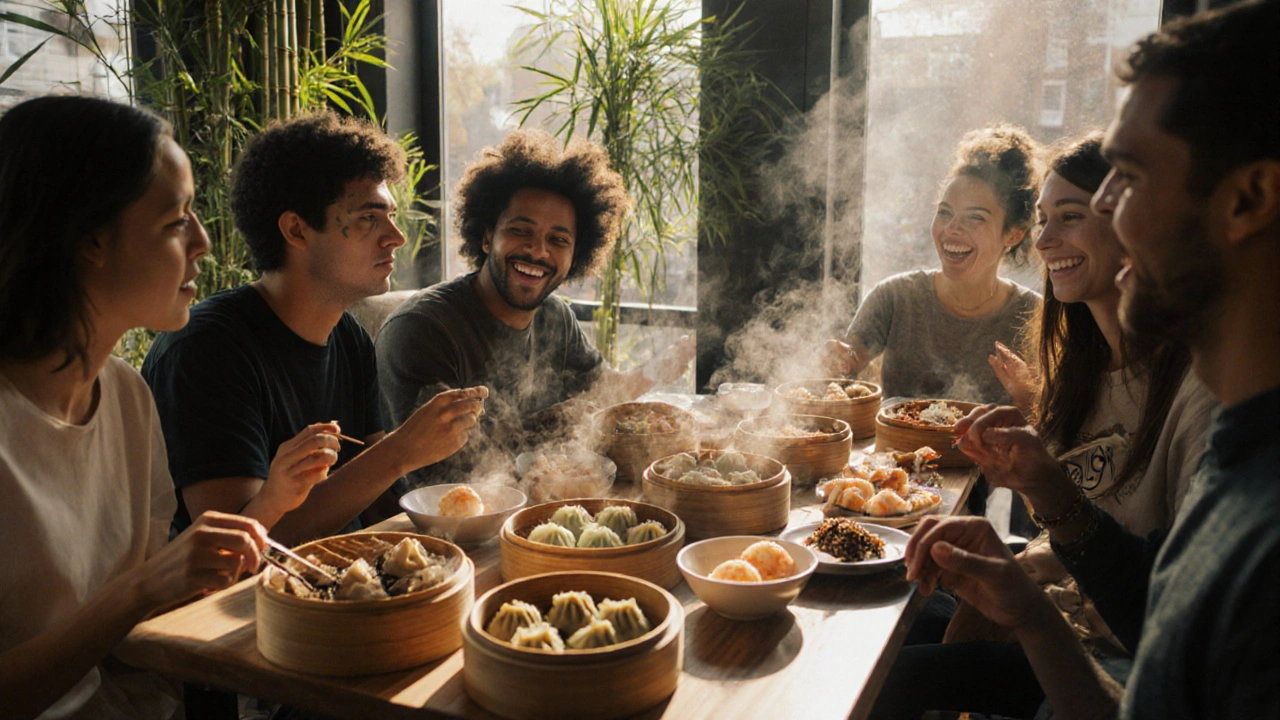London’s dim sum scene isn’t just about Chinatown anymore. Ten years ago, you’d have to trek to Gerrard Street for a decent basket of har gow. Now, you can find steaming bamboo baskets in a converted warehouse in Peckham, a minimalist basement in Shoreditch, or even a quiet corner of a Thai restaurant in Camden. The truth? The best dim sum in London isn’t always where you expect it.
What Makes Dim Sum Good?
Dim sum isn’t just small plates. It’s a ritual. The best places get the dough right-thin enough to see the filling through, but strong enough to hold up to steam without tearing. The filling should be juicy, not soggy, and seasoned with just enough soy, ginger, and sesame oil to make your mouth water without overwhelming the natural flavor of the shrimp, pork, or mushrooms.
Texture matters too. A good har gow (shrimp dumpling) should have a slight bounce when you bite into it. The char siu bao (barbecue pork bun) should be soft on the inside, slightly sweet, with a hint of smoke. And the sesame ball? It should crackle on the outside, then melt into warm, sticky red bean paste.
Most places in London serve dim sum on weekends only. That’s not a quirk-it’s tradition. The staff need time to prep the dough, fold the dumplings by hand, and steam them fresh. If you walk into a place that serves dim sum every day and the baskets look identical, you’re probably getting frozen or pre-made. Skip it.
Chinatown: The Classic, But Not Always the Best
Chinatown still has its stars. Tim Ho Wan is a Michelin-starred Hong Kong chain that brought its dim sum mastery to London in 2017. The pork dumplings here are perfect-plump, juicy, and wrapped in a delicate skin that doesn’t stick to your teeth. It’s expensive for dim sum, but you’re paying for consistency, not just flavor.
Then there’s Lucky Cat , a no-frills spot tucked behind the main drag. Their shrimp dumplings are handmade daily, and the staff will bring you extra soy sauce without asking. The chairs are plastic, the lighting is fluorescent, and the lines stretch out the door on Sundays. But the food? It’s the real deal.
Don’t miss the turnip cake here. It’s fried until crisp on the outside, then soft and savory inside, with bits of dried shrimp and preserved sausage. It’s not fancy, but it’s what your grandmother would make if she lived in Guangdong.
Chinatown’s downside? Crowds. And prices. A full dim sum meal for two can easily hit £60. If you’re looking for value, you’ll find better elsewhere.
Beyond Chinatown: Hidden Gems That Outshine the Rest
Head to Yum Cha in Soho, opened in 2019 by a chef who trained in Hong Kong’s legendary Lin Heung Tea House. This place doesn’t have carts. Instead, you order from a digital menu, and dishes arrive in small batches, still steaming. Their crab and roe dumplings are a revelation-sweet, briny, and wrapped in a translucent skin so thin it looks like lace.
They also serve a version of siu mai with duck liver and black truffle. It sounds fancy, but it’s not. It’s just good cooking. The truffle adds depth, not perfume. The duck liver melts into the pork. It’s the kind of dish that makes you pause mid-bite and wonder how they did it.
Then there’s Lai Heen in the Shangri-La Hotel at The Shard. Yes, it’s in a luxury hotel. But don’t let that fool you. The dim sum here is served with the precision of a Michelin-starred kitchen, but without the pretension. The steamed buns are light as clouds. The sticky rice wrapped in lotus leaf tastes like it was cooked over charcoal. And the egg tarts? The custard wobbles just right-sweet, creamy, with a hint of vanilla.
For a more local vibe, try Bamboo Garden in Peckham. It opened in 2023 and quickly became a favorite among young professionals and families alike. The staff are young, the music is indie pop, and the prices are fair-£12 for a basket of five dumplings, including the pork and chive and the shrimp and tofu. They even have a vegan option: mushroom and bamboo shoot dumplings that taste richer than most meat versions.

What to Order: A Simple Checklist
If you’ve never had dim sum before, start with these five classics:
- Har gow (shrimp dumpling) - the gold standard. Look for transparency in the wrapper and plump, pink shrimp inside.
- Char siu bao (barbecue pork bun) - should be fluffy, slightly sweet, with tender, caramelized pork.
- Siopao (steamed pork bun) - a Filipino twist, but common in London. Try the version with egg yolk inside.
- Turnip cake - fried until golden, served with a soy-chili dip. Don’t skip this.
- Phoenix claws (chicken feet) - not for everyone. But if you’re brave, try them. The skin is gelatinous, the meat falls off the bone.
Also, ask for puerh tea. It cuts through the grease and helps digestion. Avoid green tea-it’s too light. Puerh is dark, earthy, and perfect with dim sum.
When to Go: Timing Matters
Dim sum is a brunch thing. Most places open at 10:30 a.m. and stop serving around 3 p.m. The best time? Between 11 a.m. and 12:30 p.m. That’s when the first batch comes out of the steamer, the tables aren’t packed, and the staff still have energy.
If you go later, you’ll get the leftovers. The dumplings get soggy. The buns dry out. The tea goes cold. It’s still edible-but it’s not the same.
Weekends are busy. Book ahead if you’re going to Yum Cha or Lai Heen. For smaller spots like Bamboo Garden or Lucky Cat, just show up early. Bring a friend. The more people, the more dishes you can try.

What to Avoid
Don’t order dim sum at a place that also serves pizza or burgers. If the menu has more than 15 items, they’re probably not specializing. Dim sum is about focus.
Avoid places that use pre-made wrappers. You’ll taste the difference. It’s like comparing fresh bread to supermarket loaves.
And don’t be afraid to ask. If you’re unsure what something is, say so. Good servers will explain. Bad ones will just nod and walk away.
Final Thought: It’s Not About the Location
The best dim sum in London isn’t in Chinatown because it’s famous. It’s there because it’s been made the same way for decades. But now, the best is also in places that didn’t exist five years ago-where chefs are mixing tradition with new ideas, without losing the soul of the food.
Try one place in Chinatown. Then go to Peckham. Then try Soho. You’ll notice differences-not just in taste, but in energy, in service, in how the food makes you feel.
That’s the real magic of dim sum. It’s not just about what’s on the plate. It’s about the people who made it, the time they spent folding it, and the quiet joy of sharing it with someone you care about.
Is dim sum only served on weekends in London?
Most traditional dim sum restaurants in London serve it only on weekends, especially Saturday and Sunday mornings. This is because the preparation is labor-intensive and requires fresh ingredients. Some newer spots like Yum Cha and Bamboo Garden offer dim sum daily, but the weekend versions are usually more authentic and varied. Always check the restaurant’s website or call ahead.
How much should I expect to pay for dim sum in London?
Prices vary widely. In Chinatown, expect £10-£15 per basket (3-5 pieces). At high-end spots like Lai Heen or Tim Ho Wan, you might pay £18-£25 per basket. Budget-friendly places like Bamboo Garden charge £8-£12 per basket. A full meal for two with tea usually costs £40-£70, depending on how many dishes you order.
Are there vegan dim sum options in London?
Yes. Most good dim sum restaurants now offer at least one or two vegan options. Look for mushroom and bamboo shoot dumplings, tofu and vegetable buns, or steamed taro cakes. Bamboo Garden in Peckham has a dedicated vegan menu. Yum Cha also offers a vegan basket with jackfruit and black fungus. Always ask-the fillings can hide animal products like lard or shrimp paste.
What’s the difference between dim sum and dumplings?
All dumplings are dim sum, but not all dim sum are dumplings. Dim sum refers to a whole range of small dishes-steamed buns, fried rice rolls, congee, egg tarts, and more. Dumplings (like har gow or siu mai) are just one category. Think of dim sum as a full meal experience, not just one type of food.
Can I get dim sum for takeaway in London?
Some places offer takeaway, but it’s not ideal. Dim sum is best eaten fresh and hot. If you take it away, the wrappers get soggy, the steam escapes, and the texture changes. If you must take it, order just a few items, get it to-go in a hot box, and eat it within 20 minutes. Better yet, bring a friend and share it on the spot.
Where to Go Next
If you loved your dim sum experience, try exploring other Cantonese dishes next. Order a bowl of wonton noodle soup. Try the clay pot rice with Chinese sausage. Or head to a tea house and taste different oolongs and pu-erhs. London’s Chinese food scene is deeper than dim sum-and just as rewarding.
